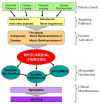Myocardial factor revisited: The importance of myocardial fibrosis in adults with congenital heart disease
- PMID: 25897907
- PMCID: PMC4446173
- DOI: 10.1016/j.ijcard.2015.04.064
Myocardial factor revisited: The importance of myocardial fibrosis in adults with congenital heart disease
Abstract
Pioneers in congenital heart surgery observed that exercise capacity did not return to normal levels despite successful surgical repair, leading some to cite a "myocardial factor" playing a role. They conjectured that residual alterations in myocardial function would be significant for patients' long-term outlook. In fulfillment of their early observations, today's adult congenital heart disease (ACHD) population shows well-recognized features of heart failure, even among patients without clear residual anatomic or hemodynamic abnormalities, demonstrating the vital role of the myocardium in their morbidity and mortality. Whereas the 'myocardial factor' was an elusive concept in the early history of congenital heart care, we now have imaging techniques to detect and quantify one such factor--myocardial fibrosis. Understanding the importance of myocardial fibrosis as a final common pathway in a variety of congenital lesions provides a framework for both the study and treatment of clinical heart failure in this context. While typical heart failure pharmacology should reduce or attenuate fibrogenesis, efforts to show meaningful improvements with standard pharmacotherapy in ACHD repeatedly fall short. This paper considers the importance of myocardial fibrosis and function, the current body of evidence for myocardial fibrosis in ACHD, and its implications for research and treatment.
Keywords: Cardiac magnetic resonance; Congenital; Heart defects; Heart failure; Myocardial fibrosis.
Copyright © 2015 Elsevier Ireland Ltd. All rights reserved.
Conflict of interest statement
Neither author has any conflicts of interest related to this topic.
Figures




Similar articles
-
Quantification of diffuse myocardial fibrosis and its association with myocardial dysfunction in congenital heart disease.Circ Cardiovasc Imaging. 2010 Nov;3(6):727-34. doi: 10.1161/CIRCIMAGING.108.842096. Epub 2010 Sep 20. Circ Cardiovasc Imaging. 2010. PMID: 20855860 Free PMC article.
-
Myocardial Fibrosis in Congenital Heart Disease.Circ J. 2016 May 25;80(6):1300-7. doi: 10.1253/circj.CJ-16-0353. Epub 2016 May 11. Circ J. 2016. PMID: 27170048
-
Myocardial T1 mapping in pediatric and congenital heart disease.Circ Cardiovasc Imaging. 2015 Feb;8(2):e002504. doi: 10.1161/CIRCIMAGING.114.002504. Circ Cardiovasc Imaging. 2015. PMID: 25657297 Review. No abstract available.
-
[Unusual abnormality of the myocardial structure in so-called idiopathic cardiac hypertrophy].Zentralbl Allg Pathol. 1967;110(4):357-62. Zentralbl Allg Pathol. 1967. PMID: 4235187 German. No abstract available.
-
Heart Failure in Adult Congenital Heart Disease: Nonpharmacologic Treatment Strategies.Cardiol Clin. 2015 Nov;33(4):589-98, viii-ix. doi: 10.1016/j.ccl.2015.07.004. Epub 2015 Aug 21. Cardiol Clin. 2015. PMID: 26471822 Review.
Cited by
-
Effects of eplerenone on markers of myocardial fibrosis, 6-minute walk distance, and quality of life in adults with tetralogy of Fallot and complete transposition of the great arteries.Proc (Bayl Univ Med Cent). 2018 Jan 3;31(1):12-19. doi: 10.1080/08998280.2017.1396176. eCollection 2018 Jan. Proc (Bayl Univ Med Cent). 2018. PMID: 29686545 Free PMC article.
-
Myocardial Fibrosis in Congenital Heart Disease and the Role of MRI.Radiol Cardiothorac Imaging. 2023 Jun 1;5(3):e220255. doi: 10.1148/ryct.220255. eCollection 2023 Jun. Radiol Cardiothorac Imaging. 2023. PMID: 37404787 Free PMC article. Review.
-
Coronary Microvascular Dysfunction in Patients with Congenital Heart Disease.Curr Cardiol Rev. 2023;19(4):e190123212886. doi: 10.2174/1573403X19666230119112634. Curr Cardiol Rev. 2023. PMID: 36658708 Free PMC article.
-
Comparison of COVID-19 Vaccine-Associated Myocarditis and Viral Myocarditis Pathology.Vaccines (Basel). 2023 Feb 5;11(2):362. doi: 10.3390/vaccines11020362. Vaccines (Basel). 2023. PMID: 36851240 Free PMC article. Review.
-
Impact of heart failure on reoperation in adult congenital heart disease: An innovative machine learning model.J Thorac Cardiovasc Surg. 2024 Jun;167(6):2215-2225.e1. doi: 10.1016/j.jtcvs.2023.09.045. Epub 2023 Sep 28. J Thorac Cardiovasc Surg. 2024. PMID: 37776991 Free PMC article.
References
-
- Warnes CA, Liberthson R, Danielson GK, Dore A, Harris L, Hoffman JI, Somerville J, Williams RG, Webb GD. Task force 1: The changing profile of congenital heart disease in adult life. J Am Coll Cardiol. 2001;37:1170–1175. - PubMed
-
- Marelli AJ, Mackie AS, Ionescu-Ittu R, Rahme E, Pilote L. Congenital heart disease in the general population: Changing prevalence and age distribution. Circulation. 2007;115:163–172. - PubMed
-
- Blalock A. Cardiovascular surgery, past and present. J Thorac Cardiovasc Surg. 1966;51:153–167. - PubMed
-
- McIntosh HD, Cohen AI. Pulmonary stenosis; the importance of the myocardial factor in determining the clinical course and surgical results. Am Heart J. 1963;65:715–716.
-
- Goldberg SJ, Weiss R, Adams FH. A comparison of the maximal endurance of normal children and patients with congenital cardiac disease. The Journal of pediatrics. 1966;69:46–55. - PubMed
Publication types
MeSH terms
Grants and funding
LinkOut - more resources
Full Text Sources
Other Literature Sources
Medical

